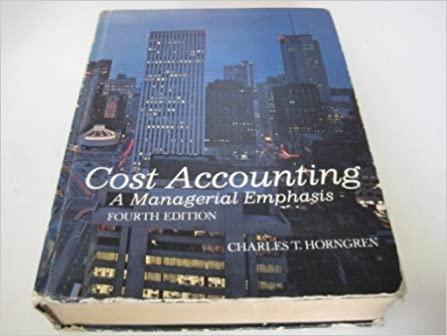Discounted Cash Flow and Evaluation of Performance John Castleman, the general manager of a division of a
Question:
Discounted Cash Flow and Evaluation of Performance John Castleman, the general manager of a division of a huge, highly diversified company, recently attended an executive training program. He learned about discounted cashflow analysis, and he became convinced that it was the best available guide for making long-range investment decisions.
However, upon returning to his company, he became frustrated. He wanted to use the discounted cash-flow technique, but top management had a longstanding policy of evaluating divisional management performance largely on the basis of its rate of return as calculated by dividing divisional net income by the net book value of total divisional assets. Therefore, in his own best interests and in accordance with the specifications of his superiors, he had to make decisions that he felt were not really the most desirable in terms of maximizing what he considered to be the “true” rate of return (that is, the discounted cash-flow rate).
Suppose Mr. Castleman had an opportunity to invest $30,000 in some automated machinery with a useful life of three years and a scrap value of zero.
The expected cash savings per year were $12,060. Compute the internal rate of return. Ignore income tax effects.
Show the effect on net income for each of the three years, assuming straightline depreciation. Also show the rate of return based on the beginning balance of the net book value of the fixed asset for each year.
Repeat requirement 2, assuming sum-of-the-years’-digits depreciation. Top management has indicated a minimum desired rate of return of 10 per- cent. After examining the results above, Mr. Castleman was more baffled than ever. He just could not see why he should invest in the machinery if his net in- come in the first year would not be at least 10 percent of the investment base. He discussed the matter with a professor at a nearby business school. The professor reacted: ““The basic trouble is not confined to your company. Many companies now insist that their managers use discounted cash-flow techniques for appraising investment opportunities, but they use conventional accounting techniques for judging operating performance. In short, one model is supposed to be used for planning, but another model is used for control. “A possible solution is to use the compound-interest method of deprecia- tion for evaluating subsequent performance. The compound-interest method is based on the same model as the discounted cash-flow technique. That is, each receipt ($12,060 in this case) consists of interest on the beginning invest- ment balance plus the recovery of principal. For example, the $12,060 cash savings during the first year would be analyzed as consisting of ‘interest’ of 10 percent of $30,000, or $3,000, plus a recovery of principal (‘depreciation’)
of $9,060.”
Repeat requirement 2, assuming the compound-interest method of depreciation.
. Contrast the pattern of depreciation in requirement 4 with the other methods.
Why is industry reluctant to use the compound-interest method of depreciation? What other means might be used to reconcile the two models described in requirement 4?
Step by Step Answer:






